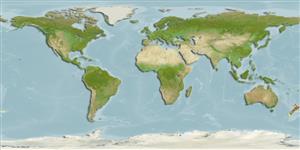>
Aulopiformes (Grinners) >
Aulopidae (Aulopus)
Etymology: Leptaulopus: Name from Greek 'leptos' meaning slender and 'aulopus' for a name long applied to the broader group of fi�shes to which the genusbelong; referring to the slender form of the speciesit comprises.; erythrozonatus: Name from Greek 'erythros' for ‘red’ and 'zone' for ‘belt’, referring to the distinctive red bands on the dorsal and caudal fins..
Environment: milieu / climate zone / depth range / distribution range
Sinh thái học
Biển gần đáy; Mức độ sâu 130 - 280 m (Ref. 94775). Subtropical
Southwestern Pacific: apparently confined to the Australasian region with a trans-Tasman distribution; recorded from New Zealand (Bay of Plenty), northern New South Wales (NE coast of North I. and off Batemans Bay), and yet to be confirmed from Norfolk Ridge.
Bộ gần gũi / Khối lượng (Trọng lượng) / Age
Maturity: Lm ? range ? - ? cm
Max length : 27.4 cm SL con đực/không giới tính; (Ref. 94775)
Short description
Hình thái học | Sinh trắc học
Các vây lưng mềm (tổng cộng): 15-16; Tia mềm vây hậu môn: 10 - 11; Động vật có xương sống: 44. This species is distinguished by the following characters: D 15-16; A 10-11; vertebrae 26 or 27 + 17 or 18 = 44; lateral line scales 44 + 1, below lateral line 4.5; predorsal scales 20; gill rakers 3 + 12; elongated snout, length 11.5-12.4% SL and 34.6-36.5% HL, which is much longer than eye diameter, dorsoventrally flattened, narrowly rounded from above; narrow bony interorbital, width 3.0-3.5% SL and 8.9-10.3% HL; snout tip to dorsal fin origin 42.5-43.7% SL in distance and 128-129% HL; anal �n base 92-9.8% SL and 27.0-29.1% HL; colour of posterior end of maxilla and posterior and ventral margins of preopercle stark white; translucent dorsal fin with 4-6 narrow submarginal stripes from base to outer edge of fin, stripes posteriorly angled obliquely, intervening spaces of fin rays white; caudal fin white with 4-5 red bands crossing each lobe and proximal bands continuous
across fin in some (Ref. 94775).
Life cycle and mating behavior
Chín muồi sinh dục | Sự tái sinh sản | Đẻ trứng | Các trứng | Sự sinh sản | Ấu trùng
Gomon, M.F., C.D. Struthers and A.L. Stewart, 2013. A new genus and two new species of the family Aulopidae (Aulopiformes), commonly referred to as Aulopus Flagfins, Sergeant Bakers or Threadsails, in Australasian waters. Spec. Div. 18:141-161. (Ref. 94775)
IUCN Red List Status (Ref. 130435)
Threat to humans
Harmless
Human uses
Thêm thông tin
Age/SizeSự sinh trưởngLength-weightLength-lengthLength-frequenciesSinh trắc họcHình thái họcẤu trùngSự biến động ấu trùngBổ xungSự phong phúBRUVS
Các tài liệu tham khảoNuôi trồng thủy sảnTổng quan nuôi trồng thủy sảnCác giốngDi truyềnElectrophoresesDi sảnCác bệnhChế biếnNutrientsMass conversion
Các công cụ
Special reports
Download XML
Các nguồn internet
Estimates based on models
Preferred temperature (Ref.
123201): 12.3 - 15.2, mean 13.9 °C (based on 12 cells).
Phylogenetic diversity index (Ref.
82804): PD
50 = 0.7500 [Uniqueness, from 0.5 = low to 2.0 = high].
Bayesian length-weight: a=0.00447 (0.00187 - 0.01067), b=3.12 (2.91 - 3.33), in cm total length, based on LWR estimates for this (Sub)family-body shape (Ref.
93245).
Mức dinh dưỡng (Ref.
69278): 4.0 ±0.7 se; based on size and trophs of closest relatives
Fishing Vulnerability (Ref.
59153): Low vulnerability (23 of 100).
